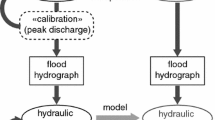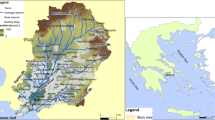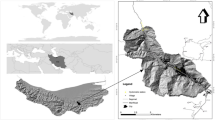Abstract
In Canada, approaches for hazard mapping involve using a hydraulic model to generate a flood extent map that distinguishes between inundated and non-inundated areas in a deterministic way. The authors adapt a probabilistic approach to obtain flood hazard maps by accounting for uncertainty in boundary conditions and calibration parameters of a hydrodynamic model, while considering extent, probability, and depth of inundation as important flood indicators. The Qu’Appelle River in the Canadian prairies is considered as a case study to demonstrate the benefits of a probabilistic approach to obtain flooding indicators. The probability and depth of inundation are obtained for all locations in the floodplain, and their uncertainties are evaluated. A sensitivity analysis to determine factors affecting the extent of flooding at multiple locations along the river is also carried out. Further, the criterion to distinguish between flooded and non-flooded areas is modified and its subsequent effect on the flooding indicators is also evaluated. Results show low variability in depth and probability of inundation at most locations along the floodplain. It is also observed that the influence of the roughness parameters on the flooding extents is higher in the steeper stretches of the river, compared to the flatter stretches. Another component of the presented work focusses on evaluating an existing topography-based hazard map for Canada that classifies the country into different levels based on severity of flooding, by comparing it with the probabilistic hazard map obtained in this study. The comparison indicates a good level of agreement between both maps and highlights the reliability of using the topography-based hazard map where hydraulic modeling is infeasible.










Similar content being viewed by others
References
Ahmari H, Blais EL, Greshuk J (2016) The 2014 flood event in the Assiniboine River basin: causes, assessment and damage. Can Water Resour J 41(1–2):85–93
Alfieri L, Salamon P, Bianchi A, Neal J, Bates P, Feyen L (2014) Advances in pan-European flood hazard mapping. Hydrol Process 28(13):4067–4077
Altman DG, Bland JM (1994) Diagnostic tests. 1: sensitivity and specificity. Br Med J 308:1552
Apel H, Aronica GT, Kreibich H, Thieken AH (2009) Flood risk analyses—how detailed do we need to be? Nat Hazards 49(1):79–98
Aronica G, Hankin B, Beven K (1998) Uncertainty and equifinality in calibrating distributed roughness coefficients in a flood propagation model with limited data. Adv Water Resour 22(4):349–365
Aronica G, Bates PD, Horritt MS (2002) Assessing the uncertainty in distributed model predictions using observed binary pattern information within GLUE. Hydrol Process 16(10):2001–2016
Bates PD, De Roo APJ (2000) A simple raster-based model for flood inundation simulation. J Hydrol 236(1):54–77
Blais EL, Greshuk J, Stadnyk T (2016) The 2011 flood event in the Assiniboine River basin: causes, assessment and damages. Can Water Resour J 41(1–2):74–84
Brunner GW (2016) HEC-RAS river analysis system. Hydraulic reference manual. Version 5.0. Hydrologic Engineering Center, Davis
Büchele B, Kreibich H, Kron A, Thieken A, Ihringer J, Oberle P, Merz B, Nestmann F (2006) Flood-risk mapping: contributions towards an enhanced assessment of extreme events and associated risks. Nat Hazards Earth Syst Sci 6(4):485–503
Candela A, Aronica GT (2016) Probabilistic flood hazard mapping using bivariate analysis based on copulas. ASCE ASME J Risk Uncertain Eng Syst Part A Civ Eng 3(1):A4016002
Chen J, Hill AA, Urbano LD (2009) A GIS-based model for urban flood inundation. J Hydrol 373(1):184–192
Chow VT, Maidment DR, Mays LW (1988) Applied hydrology. McGraw-Hill, New York, 572 pp
Cook A, Merwade V (2009) Effect of topographic data, geometric configuration and modeling approach on flood inundation mapping. J Hydrol 377(1):131–142
Crispino G, Gisonni C, Iervolino M (2015) Flood hazard assessment: comparison of 1D and 2D hydraulic models. Int J River Basin Manag 13(2):153–166
Cutler DR, Edwards TC, Beard KH, Cutler A, Hess KT, Gibson J, Lawler JJ (2007) Random forests for classification in ecology. Ecol 88:2783–2792
Di Baldassarre G, Claps P (2011) A hydraulic study on the applicability of flood rating curves. Hydrol Res 42(1):10–19
Di Baldassarre G, Montanari A (2009) Uncertainty in river discharge observations: a quantitative analysis. Hydrol Earth Sys Sci 13(6):913–921
Di Baldassarre G, Schumann G, Bates PD, Freer JE, Beven KJ (2010) Flood-plain mapping: a critical discussion of deterministic and probabilistic approaches. Hydrol Sci J 55(3):364–376
Domeneghetti A, Vorogushyn S, Castellarin A, Merz B, Brath A (2013) Probabilistic flood hazard mapping: effects of uncertain boundary conditions. Hydrol Earth Syst Sci 17(8):3127
Elshorbagy A, Bharath R, Lakhanpal A, Ceola S, Montanari A, Lindenschmidt KE (2017) Topography- and nightlight-based national flood risk assessment in Canada. Hydrol Earth Syst Sci 21(4):2219
Falter D, Vorogushyn S, Lhomme J, Apel H, Gouldby B, Merz B (2013) Hydraulic model evaluation for large-scale flood risk assessments. Hydrol Process 27(9):1331–1340
FLORIS (2005) Flood risks and safety in the Netherlands (Floris). Floris study-full report, Ministerie vanVerkeer enWaterstaat, DWW-2006-014. ISBN 90-369-5604-9
Gray DM, Landine PG, Granger RJ (1985) Simulating infiltration into frozen prairie soils in streamflow models. Can J Earth Sci 22(3):464–472
Hall JW, Dawson RJ, Sayers PB, Rosu C, Chatterton JB, Deakin R (2003) A methodology for national-scale flood risk assessment. In: Proceedings of the institution of civil engineers—water and maritime engineering, vol 156, no 3, pp 235–248
Hall JW, Tarantola S, Bates PD, Horritt MS (2005) Distributed sensitivity analysis of flood inundation model calibration. J Hydraul Eng 131(2):117–126
Horritt MS, Di Baldassarre G, Bates PD, Brath A (2007) Comparing the performance of a 2-D finite element and a 2-D finite volume model of floodplain inundation using airborne SAR imagery. Hydrol Process 21(20):2745–2759
Jafarzadegan K, Merwade V (2017) A DEM-based approach for large-scale floodplain mapping in ungauged watersheds. J Hydrol 550:650–662
Jakob M, Church M (2011) The trouble with floods. Can Water Resour. J 36(4):287–292
Jung Y, Merwade V (2015) Estimation of uncertainty propagation in flood inundation mapping using a 1-D hydraulic model. Hydrol Process 29(4):624–640
Laforce S, Simard MC, Leconte R, Brissette F (2011) Climate change and floodplain delineation in two southern Quebec river basins. J Am Water Res As 47(4):785–799
Liu L, Liu Y, Wang X, Yu D, Liu K, Huang H, Hu G (2015) Developing an effective 2-D urban flood inundation model for city emergency management based on cellular automata. Nat Hazards Earth Syst Sci Disc 2(9):6173–6199
Manfreda S, Di Leo M, Sole A (2011) Detection of flood-prone areas using digital elevation models. J Hydrol Eng 16(10):781–790
Manfreda S, Nardi F, Samela C, Grimaldi S, Taramasso AC, Roth G, Sole A (2014) Investigation on the use of geomorphic approaches for the delineation of flood prone areas. J Hydrol 517:863–876
Masood M, Takeuchi K (2012) Assessment of flood hazard, vulnerability and risk of mid-eastern Dhaka using DEM and 1D hydrodynamic model. Nat Hazards 61(2):757–770
Mazzoleni M, Bacchi B, Barontini S, Di Baldassarre G, Pilotti M, Ranzi R (2014) Flooding hazard mapping in floodplain areas affected by piping breaches in the Po River, Italy. J Hydrol Eng 19(4):717–731
Merz B, Thieken AH (2009) Flood risk curves and uncertainty bounds. Nat Hazards 51(3):437–458
Mosquera-Machado S, Ahmad S (2007) Flood hazard assessment of Atrato River in Colombia. Water Resour Manag 21:591. https://doi.org/10.1007/s11269-006-9032-4
Mukolwe M, Yan K, Di Baldassarre G, Solomatine DP (2016) Testing new sources of topographic data for flood propagation modelling under structural, parameter and observation uncertainty. Hydrol Sci J 61(9):1707–1715. https://doi.org/10.1080/02626667.2015.1019507
Murtaugh PA (1996) The statistical evaluation of ecological indicators. Ecol Appl 6:132–139
Papaioannou G, Vasiliades L, Loukas A (2015) Multi-criteria analysis framework for potential flood prone areas mapping. Water Res Manag 29(2):399–418
Pappenberger F, Matgen P, Beven KJ, Henry JB, Pfister L, Fraipont P (2006) Influence of uncertain boundary conditions and model structure on flood inundation predictions. Adv Water Res 29(10):1430–1449
Pedrozo-Acuña A, Rodríguez-Rincón JP, Arganis-Juárez M, Domínguez-Mora R, González Villareal FJ (2015) Estimation of probabilistic flood inundation maps for an extreme event: Pánuco River, México. J Flood Risk Manag 8(2):177–192
Pianosi F, Beven K, Freer J, Hall JW, Rougier J, Stephenson DB, Wagener T (2016) Sensitivity analysis of environmental models: a systematic review with practical workflow. Environ Model Softw 79:214–232
Romanowicz R, Beven K (2003) Estimation of flood inundation probabilities as conditioned on event inundation maps. Water Resour Res 39(3):1073. https://doi.org/10.1029/2001WR001056
Sarhadi A, Soltani S, Modarres R (2012) Probabilistic flood inundation mapping of ungauged rivers: linking GIS techniques and frequency analysis. J Hydrol 458:68–86
Savage JTS, Bates P, Freer J, Neal J, Aronica G (2016a) When does spatial resolution become spurious in probabilistic flood inundation predictions? Hydrol Process 30(13):2014–2032
Savage JTS, Pianosi F, Bates P, Freer J, Wagener T (2016b) Quantifying the importance of spatial resolution and other factors through global sensitivity analysis of a flood inundation model. Water Resour Res 52:9146–9163
Schumann G, Matgen P, Cutler MEJ, Black A, Hoffmann L, Pfister L (2008) Comparison of remotely sensed water stages from LiDAR, topographic contours and SRTM. ISPRS J Photogramm Remote Sens 63(3):283–296
Shen D, Wang J, Cheng X, Rui Y, Ye S (2015) Integration of 2-D hydraulic model and high-resolution lidar-derived DEM for floodplain flow modeling. Hydrol Earth Syst Sci 19(8):3605–3616
Shook K, Pomeroy JW, Spence C, Boychuk L (2013) Storage dynamics simulations in prairie wetland hydrology models: evaluation and parameterization. Hydrol Process 27(13):1875–1889
Smemoe CM, Nelson EJ, Zundel AK, Miller AW (2007) Demonstrating floodplain uncertainty using flood probability maps. J Am Water Resour As 43(2):359–371
Spear RC, Hornberger GM (1980) Eutrophication in peel inlet—II. Identification of critical uncertainties via generalized sensitivity analysis. Water Res 14(1):43–49
Szeto K, Gysbers P, Brimelow J, Stewart R (2015) The 2014 extreme flood on the southeastern Canadian prairies. Bull Am Meteorol Soc 96(12):S20–S24
Trigg MA, Birch CE, Neal JC, Bates PD, Smith A, Sampson CC, Yamazaki D, Hirabayashi Y, Pappenberger F, Dutra E, Ward PJ (2016) The credibility challenge for global fluvial flood risk analysis. Environ Res Lett 11(9):094014
Tsakiris G (2014) Flood risk assessment: concepts, modelling, applications. Nat Hazard Earth Syst Sci 14(5):1361–1369
Viero DP, D’Alpaos A, Carniello L, Defina A (2013) Mathematical modeling of flooding due to river bank failure. Adv Water Resour 59:82–94
Vorogushyn S, Merz B, Lindenschmidt K-E, Apel H (2010) A new methodology for flood hazard assessment considering dike breaches. Water Resour Res 46:W08541. https://doi.org/10.1029/2009WR008475
Wagener T, Boyle DP, Lees MJ, Wheater HS, Gupta HV, Sorooshian S (2001) A framework for development and application of hydrological models. Hydrol Earth Syst Sci 5(1):13–26
Werner MGF (2004) A comparison of flood extent modelling approaches through constraining uncertainties on gauge data. Hydrol Earth Syst Sci 8(6):1141–1152
Werner MGF, Hunter NM, Bates PD (2005) Identifiability of distributed floodplain roughness values in flood extent estimation. J Hydrol 314(1–4):139–157
Winsemius HC, Van Beek LPH, Jongman B, Ward PJ, Bouwman A (2013) A framework for global river flood risk assessments. Hydrol Earth Syst Sci 17(5):1871–1892
Wu H, Adler RF, Tian Y, Huffman GJ, Li H, Wang J (2014) Real-time global flood estimation using satellite-based precipitation and a coupled land surface and routing model. Water Resour Res 50(3):2693–2717
Wu Y, Zhong PA, Zhang Y, Xu B, Ma B, Yan K (2015) Integrated flood risk assessment and zonation method: a case study in Huaihe River basin, China. Nat Hazards 78(1):635–651
Acknowledgements
The financial support of NSERC through the strategic research network – FloodNet.
Author information
Authors and Affiliations
Corresponding author
Rights and permissions
About this article
Cite this article
Bharath, R., Elshorbagy, A. Flood mapping under uncertainty: a case study in the Canadian prairies. Nat Hazards 94, 537–560 (2018). https://doi.org/10.1007/s11069-018-3401-1
Received:
Accepted:
Published:
Issue Date:
DOI: https://doi.org/10.1007/s11069-018-3401-1




